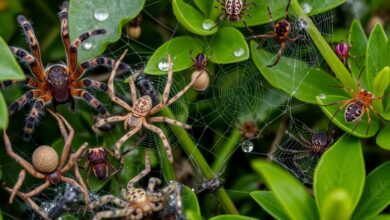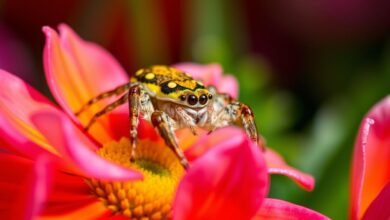Spiders: Facts and Information You Should Know
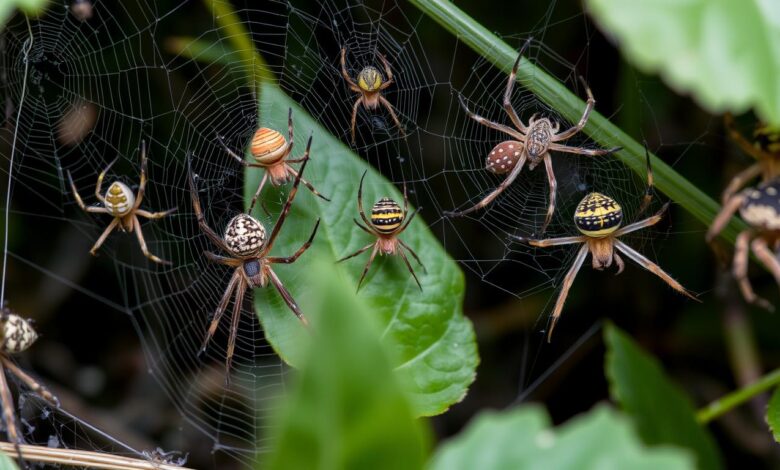
Spiders are fascinating arachnids with over 45,000 known species found all around the world. They range in size from the tiny Samoan moss spider, just 0.011 inch long, to the massive Goliath birdeater tarantula with a leg span of nearly a foot. While some spiders like the black widow and brown recluse can be dangerous to humans, the vast majority of spider species are harmless.
They play a critical role in controlling insect populations that could otherwise devastate crops. This article will explore the captivating world of spiders. We will delve into their anatomy, behaviors, silk production, web-building techniques, and the cultural significance they hold in various societies.
Fascinating World of Spiders
Spiders belong to the arachnid class, which also includes scorpions, mites, and ticks. There are over 45,000 known species of spiders. They show incredible diversity in size, shape, color, and behavior. You can find these spider species in almost every terrestrial habitat worldwide, from rainforests to deserts and cities.
Spiders: Arachnids with Incredible Diversity
Spiders vary greatly in size. The tiny Patu digua is just 0.37 millimeters, while the Theraphosa blondi, or Goliath birdeater, can have a leg span of up to 12 inches. Their colors and patterns also vary, with some having intricate designs and others blending into their surroundings.
Spiders’ Role in Controlling Insect Populations
Spiders are often feared, but they play a crucial role in controlling insect populations. They feed on many insect pests, helping to keep nature in balance. This makes them key to the health of our environment.
| Spider Species | Habitat | Prey |
|---|---|---|
| Orb-weaver Spider | Forests, gardens, urban areas | Flies, moths, beetles, grasshoppers |
| Wolf Spider | Grasslands, forests, deserts | Crickets, caterpillars, small rodents |
| Jumping Spider | Diverse habitats, including urban areas | Flies, other small insects |
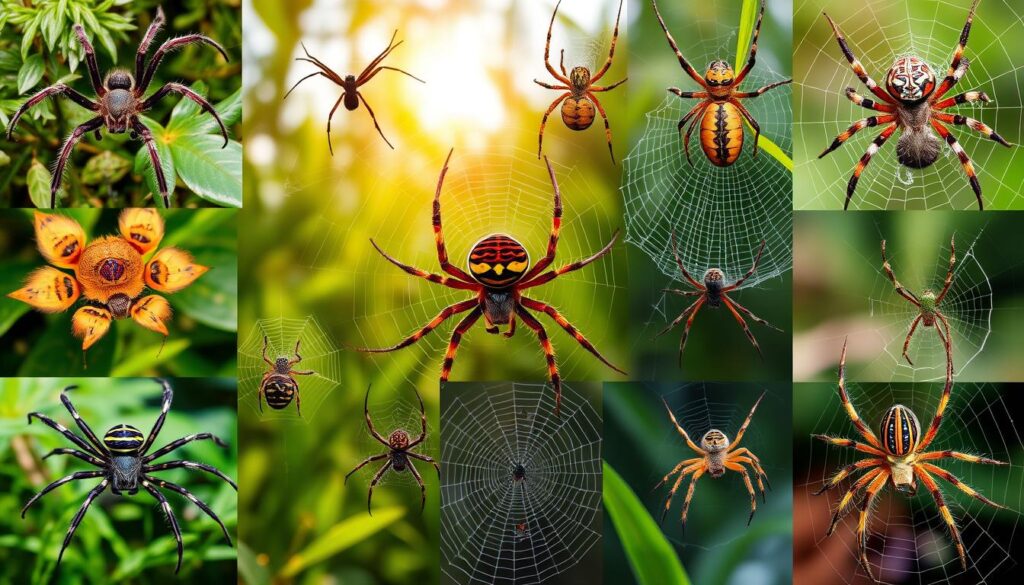
Spiders are amazing creatures with unique web designs and hunting strategies. They are vital to keeping nature and ecosystems in balance.
Spider Anatomy and Senses
Spider Eyes: Seeing the World Differently
Spiders have a unique body structure, with eight legs and two main parts. They also have special senses. Most spiders have eight eyes, but their sight varies. Some, like jumping spiders, can see colors and ultraviolet light.
Spider eyes are set up in different ways. This lets them see wide and detect movement from all sides. Their special vision helps them hunt, avoid predators, and live in many places.
| Spider Species | Visual Capabilities |
|---|---|
| Jumping Spiders | Excellent color vision, can detect ultraviolet light |
| Orb-Weaver Spiders | Primarily rely on touch and vibration to sense their surroundings |
| Wolf Spiders | Have a wide field of vision, allowing them to detect movement from multiple angles |
Learning about spider anatomy and spider senses shows how amazing they are. It helps us understand their unique ways of living and interacting with the world.

Spiders, facts and information
Spiders are fascinating creatures with many unique spider facts and information. They come in a variety of colors, patterns, and sizes. The largest spider, the Goliath birdeater tarantula, has a leg span almost as wide as a foot.
Spiders are known for their ability to make silk. Not all spiders use silk to catch prey, though. Some spiders hunt actively, while others use venom to immobilize their prey. Then, they liquefy their prey’s insides and suck out the contents.
- Spiders range from tiny jumping spiders to the massive Goliath birdeater.
- These spider biology marvels use venom to subdue their prey, showcasing their impressive hunting abilities.
- While not all spiders build webs, those that do create intricate and diverse spider facts designs to catch their food.
The spider information about these fascinating creatures continues to captivate scientists and nature enthusiasts alike. We are constantly learning about the wonders of the spider world.
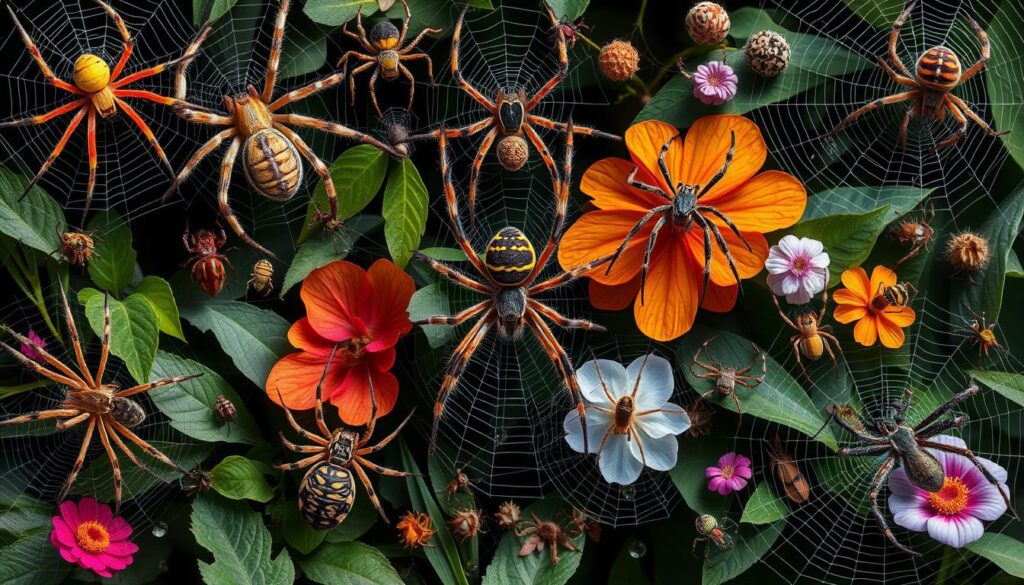
| Spider Characteristic | Description |
|---|---|
| Size | Ranging from tiny jumping spiders to the massive Goliath birdeater tarantula with a leg span of nearly a foot. |
| Venom | Spiders use their venom to immobilize and liquefy the internal organs of their prey, which they then suck out. |
| Web-Building | While not all spiders construct webs, those that do create intricate and diverse designs to catch their food. |
From their spider biology to their captivating spider characteristics, spiders continue to fascinate and inspire us. By understanding the spider facts and spider information about these incredible arachnids, we can gain a deeper appreciation for the wonders of the natural world.
How Spiders Hunt and Feed
Spiders use many ways to catch their prey. Some, like orb-weaver spiders, make complex webs to trap insects. Others, like jumping spiders, hunt actively by chasing and catching their prey.
Spiders use venom to stop their prey. Then, they break down the prey’s insides and eat it.
Venomous Spiders: Understanding the Risks
Most spider venom is not harmful to humans. But, some spiders, like black widows and brown recluses, can bite hard. Venomous spiders use their venom to catch prey, but it can also hurt humans.
It’s important to know the risks and be careful around these spiders.
| Spider Species | Venom Potency | Bite Symptoms |
|---|---|---|
| Black Widow | Highly Venomous | Severe pain, muscle spasms, nausea, and respiratory distress |
| Brown Recluse | Moderately Venomous | Necrosis of skin and tissue, fever, and nausea |
| Jumping Spiders | Minimally Venomous | Mild swelling and redness, with no serious health implications |
Knowing about venomous spiders helps us stay safe. We should respect spiders and be careful around them. This way, we can live in peace with them.

The Wonders of Spider Silk
Have you ever wondered about the amazing strength and versatility of spider silk? This protein fiber from spiders is truly amazing. It’s not just strong, but also has special properties that scientists love to study.
The way spider silk is made is fascinating. Spiders use special glands to create this fiber. They use it for many things, like making webs, wrapping prey, and keeping their eggs safe. Different spiders make silk that’s different in thickness, strength, and stretchiness.
- Spider silk is stronger than steel, yet more flexible than nylon.
- The silk from some spiders is even more stretchy than rubber.
- Some spider silks could be used in things like bulletproof vests or medical implants.
Scientists are studying spider silk to learn more about it. They want to figure out how to make something similar for many uses. As we learn more about spider silk, the ways we can use it seem endless.

The wonders of spider silk show how amazing spiders are. Whether you’re amazed by their silk’s strength or excited about its uses, spider silk is truly fascinating.
Intricate Spider Webs
The world of spider webs is a marvel of nature’s engineering. Each spider species has its own web-building techniques. This results in a stunning array of web patterns and structures.
From the elaborate spiral-shaped webs of orb-weaver spiders to the specialized traps of funnel-web spiders, the diversity of spider web designs shows their ingenuity and adaptability.
Web-Building Techniques of Different Spider Species
The web-building process of spiders is a true testament to their web design skills. Orb-weaver spiders construct their webs in a spiral pattern. Each strand is strategically placed to maximize the chances of catching prey.
Other spiders, like the funnel-web, build more specialized web traps. They use their web-building abilities to create effective hunting grounds.
The webbing itself is a marvel of engineering. Strands can be stronger than steel yet flexible enough to withstand the impact of prey. This remarkable balance of strength and flexibility shows the evolutionary adaptations of web-building spiders.
| Fascinating Comparisons | Intricate Designs in Nature |
|---|---|
|
|
|
|
|
The intricate web patterns created by spiders are a marvel of nature. They showcase the incredible diversity and adaptability of these remarkable arachnids. From the spiral-shaped webs of orb-weavers to the specialized traps of funnel-web spiders, their web-building techniques continue to captivate and inspire us.
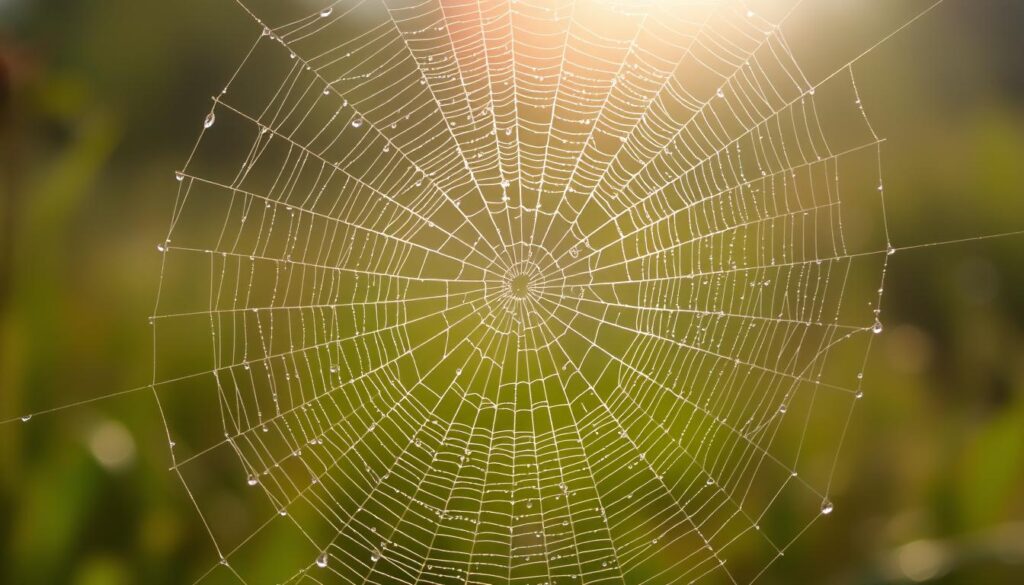
Spiders in Nature and Urban Areas
Spiders are fascinating creatures found in many places. They play a key role in controlling insect populations. This helps keep ecosystems balanced. From forests to grasslands, spiders in nature are vital to life’s web.
In cities, spiders also thrive. They find plenty of insects to eat and places to live. While some see them as pests, they actually help control other pests. Learning about spiders in cities helps us live with them better.
Spiders live in many places, from cities to wilderness. They spin webs in trees and hide in our homes. By understanding their role, we can respect these amazing creatures more. They are important to our world’s balance.

Threats to Spider Populations
Spiders are crucial for our ecosystems’ balance. Yet, they face many threats that could harm their survival. Habitat loss and the pet trade are two big challenges.
Habitat Loss: The Perils of Development
Human activities are destroying natural areas fast. This means spiders lose their homes and food sources. Habitat loss is a big problem for spiders, leading to fewer of them and even extinction for some spider species.
The Pet Trade: Unsustainable Demand
The pet trade is also hurting spider populations. Some spiders are wanted for their looks in the exotic animal market. This demand can quickly reduce their numbers in the wild, making some spiders endangered.
We’re working to save spider species and their homes. By spreading the word and using sustainable methods, we aim for a future where spiders can thrive. They play a key role in our ecosystems.

Cultural Significance of Spiders
Spiders have a big role in many cultures and myths worldwide. They are seen as symbols of creativity, patience, and perseverance. Their skill in making webs inspires art and stories.
In different cultures, spiders are seen as protectors or tricksters. Spider-related deities and legends show the complex human relationship with them. From Native American to ancient Egyptian and Chinese cultures, spiders are woven into human folklore and cultural significance.
Spiders still fascinate us in art, literature, and superstitions. They are iconic figures, loved and feared by many. This shows their cultural significance around the world.

Spiders are seen as signs of good luck or bad luck. They have left a lasting mark on human culture. By exploring our complex relationship with them, we can appreciate the spider folklore and spider symbolism that inspires us.
Spider Reproduction and Life Cycle
Spiders have a fascinating spider life cycle. Each stage has its own challenges and adaptations. From the intricate spider mating rituals and spider courtship behaviors to the production of egg sacs and the development of young spiderlings, their reproduction strategies are truly remarkable.
Some spider species can produce multiple generations in a year. They also have different ways of caring for their offspring. Spiders grow through molting, with the number of molts needed for maturity varying, especially among larger species.
Spider Mating Rituals and Courtship Behaviors
The spider mating process is a captivating display of intricate rituals and courtship behaviors. Male spiders generally do not transfer sperm directly to females. Instead, they initiate elaborate courtship displays to attract potential mates. These rituals can involve intricate dances, vibrations, and even the offering of prey or silk gifts.
In some spider species, like daddy longlegs, direct sperm transfer occurs without extensive courtship. However, many spiders exhibit a diverse range of spider courtship behaviors. Each is tailored to the specific species and their unique evolutionary adaptations.

| Spider Species | Mating Rituals and Courtship Behaviors |
|---|---|
| Black Widow | Intricate dance, offering of prey, and cautious approach to avoid cannibalism |
| Jumping Spiders | Complex visual displays, including leg-waving and body posturing |
| Orb-Weaver Spiders | Vibration signals, web-plucking, and the construction of specialized mating webs |
The diversity of spider reproduction and spider mating behaviors shows the evolutionary adaptations of these remarkable arachnids. Each species develops unique strategies to ensure the continuation of their kind.
Spiders in Popular Culture and Media
Spiders have long fascinated people worldwide, inspiring many characters and stories. From Spider-Man to Native American trickster tales, they’ve captured our imagination. These arachnids have been featured in countless stories, exploring their abilities and symbolic meanings.
Iconic Spider-Themed Characters and Stories
In movies, TV, and books, spider-themed tales have won over audiences. They show our deep fascination with these creatures. These stories, from survival tales to superhero adventures, continue to captivate and inspire.
Spiders’ suspenseful hunts and beautiful webs have won hearts globally. Exploring spiders in media reveals a world of diversity and intrigue. You’ll find a wealth of stories and characters that showcase their remarkable nature.
